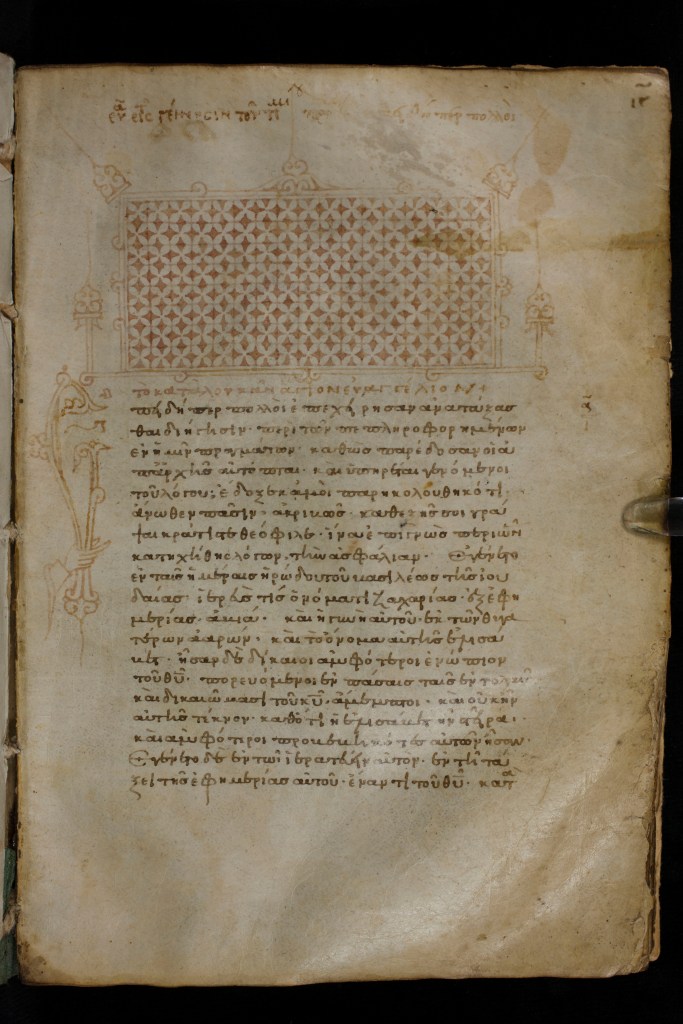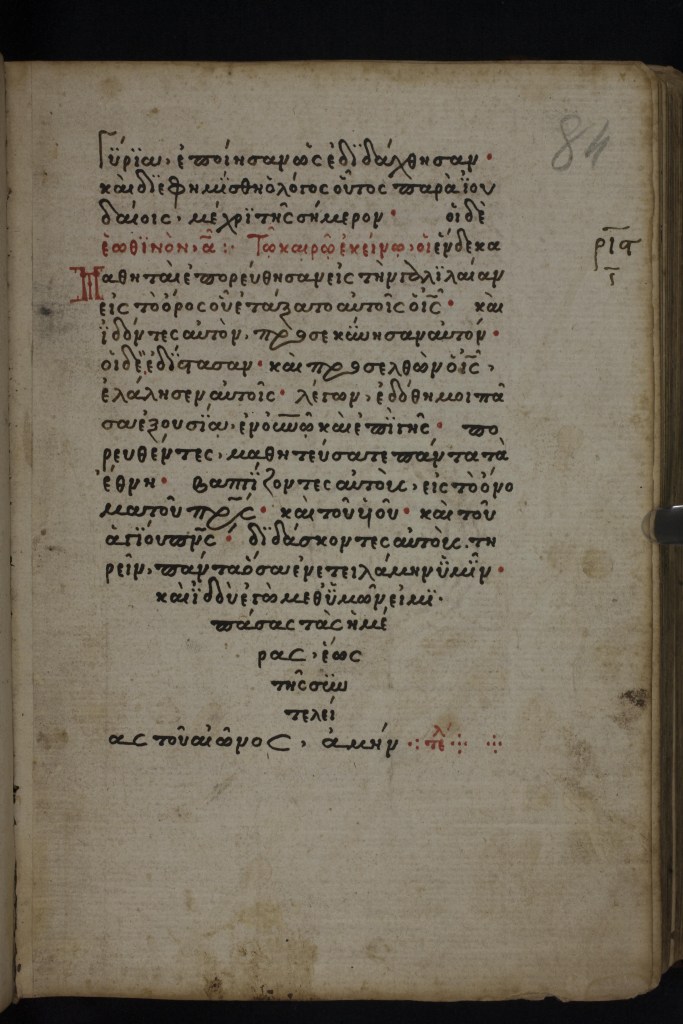By: Todd Leibovitz
We have all, at some point, entered a bookstore excited to find a new adventure or love story to read. We look at the signs indicating genres. We meander around a section perusing titles and their covers. As we decide what to read, we may ask, “Do I know the author?” “Will I like this book?” Even, “Does the plot summary sound interesting?” We rarely think, “I wonder what type of material and ink were used to make this book?” Since today’s books are printed on paper, it is outside our normal perception to think otherwise.
However, when we consider the manuscripts of the ancient world, specifically, those containing the New Testament, we encounter a variety of handwriting styles, contents, and materials. This article will look at materials used over the centuries of New Testament manuscript production.
Manuscripts of the New Testament are written on one of three different materials: papyrus, parchment, or paper. Each material is unique in its production and utility and chosen for various reasons depending on availability and economics.
Papyrus
Papyrus was a common material in the ancient world. It grew along riverbanks and deltas and was easily picked by hand. Despite the ease of harvesting, converting papyrus into a writing medium took time and effort. Papyrus-making only occurred in a few cities in the ancient world. Strips of papyrus were laid perpendicularly on top of each other. These were then glued to each other, creating a roll. Rolls could be up to about 35 feet long. Later craftsmen would
bind sheets of papyrus together to form codices, an ancient book from that grew popular over the early centuries A.D. Extant papyrus manuscripts, even the oldest ones, take the form of the codex.
Today, the papyrus manuscripts of the New Testament are mostly fragmentary and contain only a small portion of what would have originally been produced. Some of these papyri are so fragmentary that they contain only a few verses or letters from a New Testament passage. A great example is P52, the oldest extant NT manuscript. The fragment, dated by Orsini and Clarysse to 125-175 CE, contains John 18:31-33 and 18:37-38.
Unfortunately, papyrus deteriorates quickly when exposed to moisture. As such, only some papyrus manuscripts have survived. Despite their scarcity, papyrus manuscripts we have today reference every book of the New Testament except 1 and 2 Timothy.
Parchment
Parchment, also known as vellum, was made by preparing animal hides, typically from sheep or goats. Creating this writing material involved several steps.
First, the hide would be cleaned and dehaired by soaking it in a mixture of water and lime. The hair would then be removed by scraping or shaving it off. After the hide was cleaned and dehaired, it would be soaked in a lime solution to soften it and neutralize any remaining hair or fat. The next step involved stretching the hide on a frame and scraping it with a knife or other tool to thin it and remove any impurities. This process, called “scudding,” helped align the fibers of the hide in preparation for subsequent stretching.
Finally, the parchment would be stretched again and left to dry. Then, the craftsman smoothed and burnished the hide to give it a smooth surface. He could then cut it to the desired size. This process resulted in a durable and flexible parchment suitable for writing on with a quill or reed pen.

Some of the earliest copies of the Christian Scriptures were written on parchment. These manuscripts are of great significance in biblical studies for several reasons. First, they provide valuable insight into the text of the New Testament and how it developed over time. Many of these parchment manuscripts contain variations from the text found in modern Bibles, offering scholars the opportunity to study the textual history of the New Testament.
Second, parchment manuscripts of the New Testament provide a glimpse into the early history of Christianity. Their historical value is incalculable. They also offer insight into the cultural and social context of their time. Third, parchment manuscripts of the New Testament are significant for their artistic value. Some contain intricate illustrations and decorations reflecting the artistic style of the period. These manuscripts are considered unique and valuable pieces of art and history.
Overall, parchment manuscripts of the New Testament are of great significance in the field of biblical studies, as they provide valuable insight into the text of the New Testament and its development, historical context, and artistic value. They are a unique and valuable part of the Christian heritage, making their careful preservation all the more important for continued study today.
Paper
In the 9th century, paper, made from pulped plant fibers, appeared as an alternative to parchment. Initially, paper was used infrequently. However, in the 12th century, the product grew in use and popularity. Boasting a cheaper production cost than parchment, paper provided an accessible option to a broader range of people, including the lower classes. Over time, it became easier to produce high-quality paper in large quantities. Additionally, paper was much more convenient to use: it was lighter, easier to store, and could be produced much more quickly than parchment. Of all extant NT manuscripts, roughly 1,300 are written on paper.
Inks
In ancient times, carbon ink was a widely used writing material for papyrus. It was made from a mixture of charcoal or lampblack, water, and a small amount of gum arabic to enhance the thickness. However, this earlier form of ink was not suitable for parchment, leading to the creation of iron gall ink. Made from oak galls and ferrous sulfate, the ink was commonly referred to as “copperas.” Oak galls contain high levels of tannic and gallic acids. The galls were crushed and infused in rainwater, and then combined with ferrous sulfate, resulting in black ink. The ink was thickened with a small amount of gum arabic. Over time, iron-gall ink darkens when exposed to air and takes on a rusty brown hue. Besides these more common ink materials, we find colorful variations in some manuscripts. Luxurious editions were written with gold and silver inks on purple-dyed vellum. Other standard editions written in black or brown ink contain decorative elements in blue, yellow, or the most popular color, red.

GA 043, Albanian National Archives, Tirana, Albania

GA 793, National Library, Athens, Greece
The materials that make up the thousands of New Testament manuscripts remaining today do more than provide a helpful way of classifying these historic artifacts. The materials can also indicate the time, region, and situation of the manuscript’s production. Simple details that we rarely consider about books today teach us about this particularly special ancient book and the text that has been passed down through centuries.
Todd Leibovitz works on staff at the Center for the Study of New Testament Manuscripts as the Office and Events Manager. He is currently studying at Dallas Theological Seminary in the Master of Theology (Th.M.) program with an emphasis on New Testament. Besides keeping all things CSNTM on track and planning for upcoming events, Todd is a proven master of furniture assemblage who regularly responds to our ever-present need for more bookshelves. He enjoys learning about and discussing New Testament textual criticism, theology, and the latest tech.







